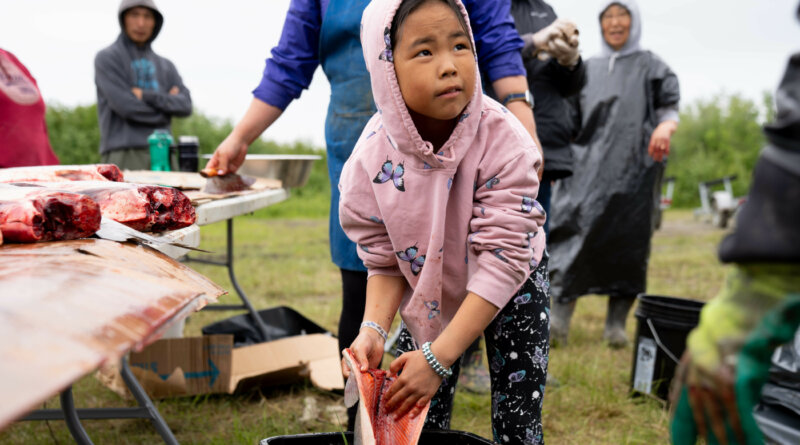An Alaska district aligns its school year to the harvests : NPR

Students from the Yupiit School District learn how to prepare freshly caught salmon.
MaryCait Dolan/KYUK
hide caption
toggle caption
MaryCait Dolan/KYUK

Students from the Yupiit School District learn how to prepare freshly caught salmon.
MaryCait Dolan/KYUK
Seventy miles inland from the Bering Sea, on roadless lands beside the Kuskokwim River, three Yup’ik villages are perfect examples of the educational challenges faced in Alaska.
Teacher turnover in the state runs 25% to 30% a year, and poor attendance and low test scores have been constant issues in many rural schools.
In the mid-1980s, the villages of Akiachak, Akiak and Tuluksak, broke away from a bigger district to form the Yupiit School District. They wanted to provide an education that more fully embraced traditional Yup’ik Native knowledge.

Salmon caught near Akiachak, Alaska, is processed with an uluaq.
MaryCait Dolan /KYUK
hide caption
toggle caption
MaryCait Dolan /KYUK

The Akiachak School in Akiachak, Alaska.
MaryCait Dolan /KYUK
hide caption
toggle caption
MaryCait Dolan /KYUK
This year, the district was allowed to operate on an academic calendar that’s aligned with seasonal subsistence harvests. School leaders spent much of 2022 working to get it approved by the state.
It starts a week later than other districts in the state, and classes finish 10 days earlier. They make up the difference with an extra half hour of instruction each day.
Students can now take part in the fall moose hunt and the spring migratory bird harvest. The strategy is to pass along traditional knowledge that cannot be gained in the classroom, and attendance was already poor during seasonal harvests.

Students from the Yupiit School District go drift netting for salmon.
MaryCait Dolan/KYUK
hide caption
toggle caption
MaryCait Dolan/KYUK

While the first drift only yields two fish, the second brings in around a dozen: a mixture of reds, kings, and chums. The students scream in delight as the squirming salmon are picked from the net, landing with a thud in a plastic tote.
MaryCait Dolan /KYUK
hide caption
toggle caption
MaryCait Dolan /KYUK
Summer culture camp
In the summer, Yupiit schools offer culture camp.
On an overcast day this June, teachers and elders meet students at a large cutting table near teacher housing near the river. Originally, the morning catch of salmon was supposed to be processed at a nearby community fish camp, but those plans were scrapped because a black bear was hanging around.
Literacy coach Evelyn Esmailka wields a large ulu as she explains the differences between chum, chinook, and sockeye salmon to the small group of children. After this lesson, the kids will board drift boats to go fishing for salmon on the river.

Barron Sample, principal of the Akiachak School, prepares to take students out drift netting.
MaryCait Dolan /KYUK
hide caption
toggle caption
MaryCait Dolan /KYUK

Fish hangs to dry at a fish camp near Akiachak, Alaska.
MaryCait Dolan/KYUK
hide caption
toggle caption
MaryCait Dolan/KYUK
“They’re getting ready to go out. This will be for the winter supply of fish, [to] supplement the lunch program,” Esmailka said.
After the fish are cleaned, they are loaded into the back of a beat-up truck to be dropped off at the school’s walk-in freezer. Salmon blood, to be returned back to the river, sloshes around in plastic totes as the truck lurches along Akiachak’s heavily potholed main drag.
Woody Woodgate, the school district’s federal programs director, said that staff favor indigenous foods in the district’s cafeterias.
“Not really taking anything away from the [United States Department of Agriculture] and the school lunch program, but most of that stuff that’s on those menus is designed for people in big cities, the lower 48, and a lot of it just goes into the trash can because kids don’t wanna eat the food,” Woodgate said. “So if we can supplement with fish and moose, and especially fish and moose that the kids catch.”

A student from the Akiachak School holds up a king salmon.
MaryCait Dolan /KYUK
hide caption
toggle caption
MaryCait Dolan /KYUK
Taking part in the harvest
With the exception of sockeye, the salmon runs on the Kuskokwim River are crashing, and the day the kids were out was one of the limited opportunities to fish for them. As time ticked away on the 12-hour salmon fishing opener, the order of the day was making sure that every student gets a chance to take part in the harvest.
Barron Sample was in charge of the drift net fishing component of the summer culture camp. He is in his third year as principal at the Akiachak School.

Salmon caught near Akiachak, Alaska.
MaryCait Dolan/KYUK
hide caption
toggle caption
MaryCait Dolan/KYUK

A fish camp near Akiachak, Alaska.
MaryCait Dolan /KYUK
hide caption
toggle caption
MaryCait Dolan /KYUK
“For some of them, it’s the first time actually out here on the river doing this, and the first time they’re actually pulling a net,” Sample said.
The 24-foot boat is one of three owned by the school district.
“There’s three schools in our school district: Akiak, Tuluksak, and us, Akiachak. So, kind of in a little competition, like, ‘how many did you catch today?'” Sample said.
After a 150-foot gillnet was unfurled, the boat drifted slowly down the river. The children intently watched a line of buoys for signs of life.

Students from the Yupiit School District learn how to prepare freshly caught salmon.
MaryCait Dolan /KYUK
hide caption
toggle caption
MaryCait Dolan /KYUK
“Fifteen more minutes and then we’re gonna reel it in,” a fourth-grader informs the crew.
While the first drift only yields two fish, the second brings in around a dozen: a mixture of reds, kings, and chums. The students scream in delight as the squirming salmon are picked from the net, landing with a thud in a plastic tote.
“I wanna fish again. This is actually a good spot to fish,” a fourth-grader chimes in.

Students from the Yupiit School District go drift netting for salmon.
MaryCait Dolan/KYUK
hide caption
toggle caption
MaryCait Dolan/KYUK
After two drifts, there are plenty of fish to be processed and stored at the school for the coming winter. All the kids can talk about is going out again.
During the narrow window when fishing was allowed, the village of Akiachak felt like a ghost town. But along the river, the fish camps buzzed with activity as families processed the day’s harvest in a way that has changed little over the centuries.




